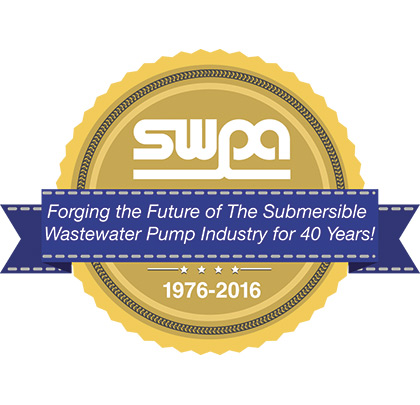Pressure sewer systems using grinder pumps are the popular choice for contractors and developers looking to avoid the troubles of poor soil conditions, failing septic systems, and environmental damage. Because they can be customized to site-specific needs and expanded upon unit by unit, pressure sewer systems using grinder pumps can be connected to as expansive a system as needed, yet maintain the reliability of its initial design. In this month’s SWPA Insight, SWPA members Walt Erndt of Crane Pumps and Systems and Clark Henry of Environment One Corporation answer your questions about these efficient and economical systems.
Pressure sewer systems have been in widespread use since the 1970s, but for those unfamiliar with their applications what are the key differences between conventional gravity sewer systems and a pressure sewer system?
Gravity sewer systems have been used since ancient times. They are an ancient technology that involves digging wide, downward sloping trenches. Okay for going downhill, but it’s challenging when the terrain is uncooperative. The deeper you go, the more it costs to dig. In addition, you have to periodically raise the sewage along the way with lift stations to restart the gravity flow. So it’s even harder if you’re going uphill and takes more lift stations. It’s also more costly when digging through rocky or sandy soil and traveling over long distances.
Unlike conventional gravity sewer systems that must continually slope pipe downward to allow gravity to transport sewage, no gravity is required to operate a pressure sewer system. A pressure sewer system uses submersible grinder pumps that grind sewage particles into a slurry and moves it along. The system uses smaller diameter pipes that are less expensive and easier to install. Plus the pipes follow the terrain and move directionally to skirt obstructions. The result is a significantly lower cost of installation compared to traditional gravity systems.
Grinder pumps are the most common method to power a pressure sewer system. What are some of the strengths of grinder pump stations?
A grinder pump station is a self-contained appliance that consists of a wastewater-holding basin, a grinder pump, on-off controls and a high water alarm. A grinder pump is a pump with a “grinding” mechanism (much like a garbage disposal), that grinds the waste solids into a slurry. Therefore, your pump is not pumping any solids. Because you are not pumping solids, a smaller diameter force main may be used. The system is engineered with specific features for residential applications.
Also, the design of the pump will virtually eliminate a clogged discharge line due to sediment buildup. Unlike other appliances or equipment in your home, no periodic maintenance is required for a grinder pump station. The grinder system is designed to be virtually maintenance-free for long periods. Because the grinder pump in the station is a low horsepower device it cost very little to operate, but by design has the power to pump sewage for miles.
How do pressure sewer systems adapt to different terrains?
Pressure sewers are ideally suited for installation in challenging locations such as rocky, flat, wet, or hilly terrain. Pressure sewer systems use small diameter flexible mains that are installed just below the frost line, eliminating the need for deep trenches and expensive excavation that gravity sewer systems usually require. Directional drilling can offer additional benefits including little to no disruption of the land. In areas with high water tables the need for dewatering is often eliminated. In flat land installations the need for expensive lift stations are reduced or even eliminated.
What are the environmental impact of grinder pumps and pressure sewer systems? What solutions have they provided in contrast to conventional gravity sewer systems?
One might at first think gravity-based systems are a more passive and hence an eco-friendly choice when compared to pressure sewers, but a closer look will tip the scales. Laying a traditional gravity-based system requires installing large pipes at exact grade and moving a lot of material. When you install a gravity system the smallest pipe you use is 6 inch diameter and the largest for a larger subdivision 30 inches. The gravity sewer installation requires work crews to, exactingly, dig deep, wide trenches to lay the pipe and that can be incredibly disruptive to habitat. For a communities built on rock in an ecologically sensitive zone, this groundwork is especially difficult, energy intensive, destructive and expensive.
Additionally, when laying a gravity-based system, manholes must be placed at every pipe-turn. These become entry points for runoff, organic debris and garbage. That means more maintenance and treatment plants are left to process larger flow volumes during rain events that are more complex and less predictable. Gravity sewer treatment is energy intensive, more expensive and requires additional treatment of inflowing groundwater. Pressure sewer systems use small 1-¼-inch flexible pipe creating a much smaller carbon footprint and the only entry points into the system from home site to treatment facility are the homes themselves. With no secondary manhole leakage, treatment is simpler, demands less energy, and it’s easier to predict. ◆
For More Information:
SWPA has developed a grinder pump and pressure sewers manual that is available for purchase on the SWPA website at www.swpa.org. You may also download SWPA’s grinder pump and pressure sewers power point presentation free of charge from SWPA’s website.
____________________________________________
MODERN PUMPING TODAY, July 2016
Did you enjoy this article?
Subscribe to the FREE Digital Edition of Modern Pumping Today Magazine!
![]()


